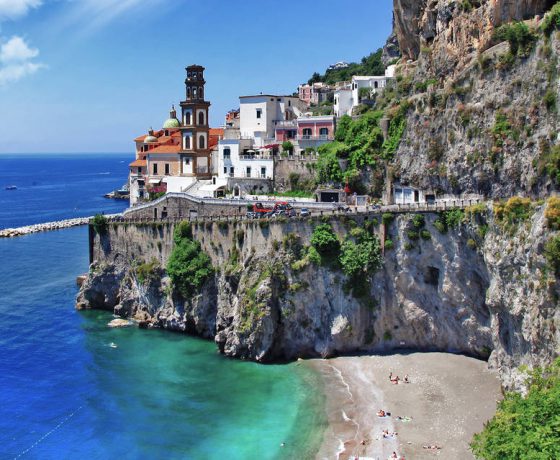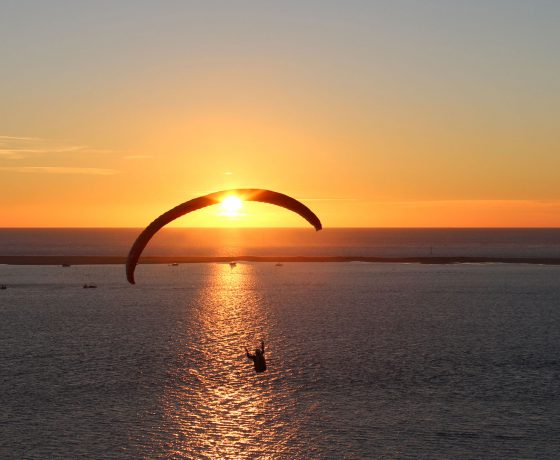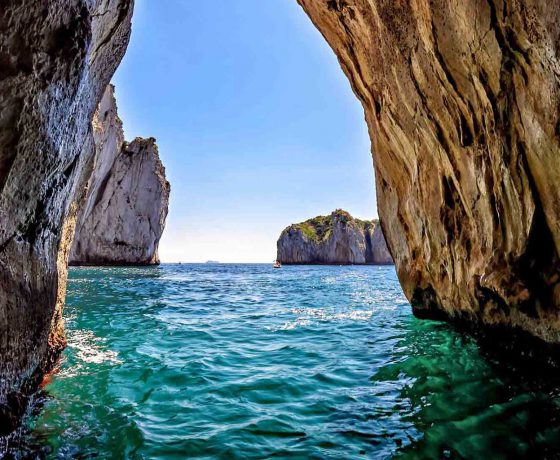Salerno
A busting and ample waterfront, an elegant city centre with 19th century’s buildings gathered around its medieval core. The vast extension of the Gulf dominated by the Arechi Castle and a rich fertile land. Salerno is a modern city that is enriched with precious artistic and historical memory, closely tied to its traditions but at the same time open to innovation.
Salerno has a big, busy port which is currently the subject of an heavy architectonic intervention that involves the waterfront area, where the buildings, designed by the famous architect Santiago Calatrava (Project manager of the “City of Science” of Valencia) are currently being constructed.
Once famous for its school of medicine (12th century), it is visited for its Duomo (an 11th century’s cathedral) and the Atrium, whose columns come from the nearby Paestum. In the crypt you can find the tomb of the one of the apostles of Christ: St Matthew, who is the patron Saint of the city. This was brought here in 954 and every year on September 21st Salerno celebrates the St. Matthew feast day with a traditional procession and fireworks in the sea.
The Duomo was consecrated by Pope Gregory VII in 1085, however It has been modified several times in the following centuries. In 1688 the architect Ferdinando Sanfelice rebuilt the interior of the Duomo using the Neapolitan Baroque style and the Rococo Architecture. Finally, a restoration in the 1930s brought it back to an appearance similar to the original one. Historically, the Duomo is remembered as the initial symbol of the Italian Renaissance, due to presence of the tomb of Pope Gregory VII inside, who started the rejection from Italy of the German domination of the Holy Roman Empire. The Duomo was damaged during the Operation Avalanche, when the Allies landed in Salerno in September 1943, during World War II and today it is the most visited attraction of the city.
The Museo Diocesano is home to most of the cathedral treasures , including an 11th century ivory altar-front called the Paliotto.
Before wandering off to the busting Corso Vittorio Emanuele, we suggest visiting the Museo Provinciale for local archeological finds.
The “Centro Storico of Salerno”, (Historical city center of Salerno) is believed to be one of the best maintained in the Italian peninsula. Its “Via dei mercanti” (merchant street) is the main bulk of the shopping in the city. Nearby you will find the “Garden of Minerva” (Giardino della Minerva) which is situated on the fringes of the Castle hill that overlooks the old Salerno. You will have the opportunity to see the medieval “Hortus sanitatis” of the Schola Medica Salernitana (the most important source of medical knowledge in Europe in the early Middle Ages) and the first European “Orto Botanico” (botanic garden).
The Salerno Theater (“Teatro Verdi“) was made in 1872 and is decorated with paintings of Gaetano D’Agostino. The theater was heavily damaged during the 1980 earthquake and rebuilt in 1994 during the celebrations for the fifty years of “Salerno Capital of Italy“. Today is a famous venue for many events.
The Christams lights are another popular attraction of Salerno. Since 2006 this event, called Luci D’Artista, has attracted thousands of tourists from all over Italy but also from the rest of Europe. The light panels designed by Nello Ferrino, decorate the City from October to January, giving Salerno a very special charm. Stroll through the medieval streets of Salerno’s old town through Il Giardino Incantato (The Enchanted Garden), where you’ll discover dragons and fairies surrounded by a world of colorful floral lights. It’s a magical setting for shopping in Italy.
From Salerno you can easily reach, not only the Amalfi Coast, but even the Cilento Coast. The Cilento National Park is not as popular as the Amalfi Coast, but it has locations appreciated all over the World.
With an amazing and still wild coastline, on emerald sea and breathtaking caves and beaches, you will see Paestum. Founded around the end of the 7th century BC by colonists from the Greek city of Sybaris, and originally known as Poseidonia. The highlights of the site today are the standing remains of three major temples in Doric style, that are from the first half of the 6th century BC. These were dedicated to Hera and Athena, although they have traditionally been identified as a basilica and temples of Neptune and Ceres, owing to 18th-century mis-attribution.
The Cilento area deserves a stop, even for its gastronomic tradition. First of all, the Buffalo mozzarella (Mozzarella di Bufala) that it feels like eating milk clouds. With DOP brand (Protected Designation of Origin) is very famous in the World, but only here you can taste the real Mozzarella. From Salerno to Agropoli, passing it through Battipaglia which is the Mozzarella di Bufala birthplace, you will find a lot of cheese factories. You can also assist at the production process and taste all products made with Buffalo cheese (Mozzarella, cheese, yogurt).
Don’t miss the olive oil tasting and the typical wine. The surroundings of Salerno are full of typical special gastronomic products: The pomodoro San Marzano which is the tomato defined “the red gold” of Salerno, wines such as the Aglianico, Fiano and obviously the Amalfi Coast wines.
Surely, here you will have lots of things to do; from art to culture, sea and relax, wine and food tasting. Salerno is the perfect destination due to to its strategical position: between the Amalfi Coast and the National Park of Cilento and therefore very well connected to the most important attractions of the South of Italy!












